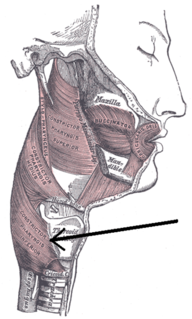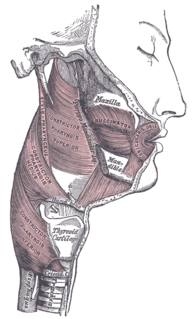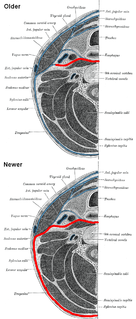
The glottis is the opening between the vocal folds.
Swallowing, sometimes called deglutition in scientific contexts, is the process in the human or animal body that allows for a substance to pass from the mouth, to the pharynx, and into the esophagus, while shutting the epiglottis. Swallowing is an important part of eating and drinking. If the process fails and the material goes through the trachea, then choking or pulmonary aspiration can occur. In the human body the automatic temporary closing of the epiglottis is controlled by the swallowing reflex.

A pharyngeal consonant is a consonant that is articulated primarily in the pharynx. Some phoneticians distinguish upper pharyngeal consonants, or "high" pharyngeals, pronounced by retracting the root of the tongue in the mid to upper pharynx, from (ary)epiglottal consonants, or "low" pharyngeals, which are articulated with the aryepiglottic folds against the epiglottis in the lower larynx, as well as from epiglotto-pharyngeal consonants, with both movements being combined.

In embryogenesis, Rathke's pouch is an evagination at the roof of the developing mouth in front of the buccopharyngeal membrane. It gives rise to the anterior pituitary (adenohypophysis), a part of the endocrine system.

The Inferior pharyngeal constrictor, the thickest of the three constrictors, arises from the sides of the cricoid and thyroid cartilage. Similarly to the superior and middle pharyngeal constrictor muscles, it is innervated by the vagus nerve, specifically, by branches from the pharyngeal plexus and by neuronal branches from the recurrent laryngeal nerve.

The superior pharyngeal constrictor muscle is a muscle in the pharynx. It is the highest located muscle of the three pharyngeal constrictors. The muscle is a quadrilateral muscle, thinner and paler than the inferior pharyngeal constrictor muscle and middle pharyngeal constrictor muscle.

The stylopharyngeus is a muscle in the head that stretches between the temporal styloid process and the pharynx.

The retropharyngeal space is a potential space of the head and neck, bounded by the buccopharyngeal fascia anteriorly and the alar fascia posteriorly.

The stomodeum, also called stomatodeum or stomatodaeum, is a depression between the brain and the pericardium in an embryo, and is the precursor of the mouth and the anterior lobe of the pituitary gland.

The region where the crescentic masses of the ectoderm and endoderm come into direct contact with each other constitutes a thin membrane, the buccopharyngeal membrane, which forms a septum between the primitive mouth and pharynx. In front of the buccopharyngeal area, where the lateral crescents of mesoderm fuse in the middle line, the pericardium is afterward developed, and this region is therefore designated the pericardial area.
A stertor is a respiratory sound characterized by heavy snoring or gasping. It is caused by partial obstruction of airway above the level of the larynx and by vibrations of tissue of the naso-pharynx, pharynx or soft palate. It is low-pitched, non-musical, and occurs during the inspiratory phase only. In general terms it is a snoring or snuffly sound. Stertorous breathing will be audible during the post-ictal phase after a tonic-clonic seizure.

The pharyngeal muscles are a group of muscles that form the pharynx, which is posterior to the oral cavity, determining the shape of its lumen, and affecting its sound properties as the primary resonating cavity.

The pterygomandibular raphe is a ligamentous band of the buccopharyngeal fascia, attached superiorly to the pterygoid hamulus of the medial pterygoid plate, and inferiorly to the posterior end of the mylohyoid line of the mandible.

The prevertebral fascia is a fascia in the neck.

The buccopharyngeal fascia is a fascia in the head.
The pharyngeal aponeurosis, is situated between the mucous and muscular layers.

The retropharyngeal lymph nodes, from one to three in number, lie in the buccopharyngeal fascia, behind the upper part of the pharynx and in front of the arch of the atlas, being separated, however, from the latter by the Longus capitis.

Benzoxonium chloride (Absonal) is an antiseptic and disinfectant.

The pharynx is the part of the throat behind the mouth and nasal cavity, and above the esophagus and larynx – the tubes going down to the stomach and the lungs. It is found in vertebrates and invertebrates, though its structure varies across species.
Halzoun is the local name of a buccopharyngeal infection occurring in Lebanon, probably caused by pentastomida larvae of Linguatula serrata which wander into the throat of the human host after ingestion of infected raw liver or lymph nodes from sheep or goats.
This page is based on this
Wikipedia article Text is available under the
CC BY-SA 4.0 license; additional terms may apply.
Images, videos and audio are available under their respective licenses.














